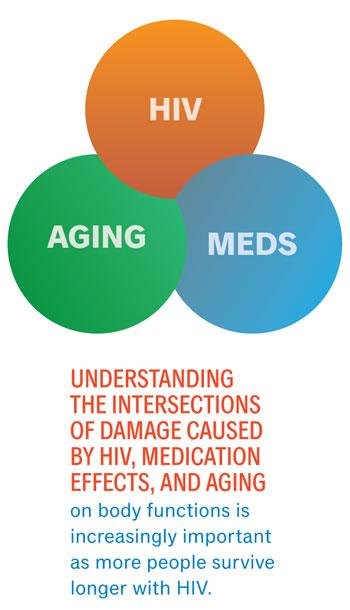
Aging is an unavoidable characteristic of living. As we get older, our bodies change. Outwardly, our skin develops wrinkles, our hair grays, and inside we change as well. Organ systems become less efficient. Although the American Association of Retired Persons (AARP) defines a “senior” as anyone over the age of 55, more significant physiologic and functional changes show up for most people in their seventh decade and beyond.
HIV disease also causes destruction of cells and organs in our bodies. Some changes are slowed or reversed with medicines that help control the virus, and some may be accelerated by these medications. Although uncontrolled HIV shortens life, several studies in Europe and North America have shown the narrowing difference between life expectancies for people with well-controlled HIV infection and those without HIV.
The question most often asked by gray-haired people with HIV when a symptom or change is noted: “Is this due to aging, HIV, or the meds I take?” However, the more important question is: “What can be done to limit these changes?” Aging cannot be stopped, and the medicines to control HIV are life-saving. But we can choose medicines that have less impact; we can change behaviors to reduce the risks of HIV and of aging-related impacts.
Understanding the intersections of damage caused by HIV, medication effects, and aging on body functions is increasingly important as more people survive longer with HIV. This is an abbreviated look at diseases in three organ systems with an overlap between aging and HIV that are most commonly of concern to my patients.
HEART DISEASE
Heart disease includes a number of illnesses. HIV causes damage to the heart muscle, as well as inflammation that can reduce the heart’s effectiveness in pumping blood by causing cardiomyopathy (weakening of the heart muscle), endocarditis (inflammation of the heart’s inner lining), or pericarditis (irritation of the membrane that encloses the heart).
However, the leading cause of heart-associated death among people with HIV is cardiovascular, specifically coronary artery disease. That is disease of the blood vessels that feed the heart. Coronary artery disease is affected by a number of factors. A heart attack happens when the blood vessels (arteries) to the heart itself are clogged enough to prevent blood from flowing to the heart muscle. The muscle cells die without the oxygen carried in the blood. The death of heart muscle is a myocardial infarction (MI), or heart attack.
Atherosclerosis or “hardening of the arteries” increases over our lifespan at different rates depending on our genetic make-up and our lifestyle choices. For example, people who eat diets with higher levels of animal fats, who do not exercise, who become obese, and who smoke are at higher risk of heart attacks at all ages. HIV is associated with increased formation of atherosclerosis. A number of studies show premature atherosclerosis levels in people with HIV compared to age- and risk-matched HIV-negative individuals. These changes are known to be accelerated by the chronic high level of inflammation associated with HIV (at a lower level in even well-controlled HIV disease), and may be exacerbated by some antiretroviral medicines.
Critical to avoiding heart disease is to reduce the inflammation associated with HIV by using ART (antiretroviral therapy). The suppression of HIV is associated with lessening of inflammation. Controlling the viral levels has been shown to lower risk of cardiac death. Studies have shown up to a 70% decreased hazard for cardiac events for people with HIV who start ART medicines sooner rather than later.
Some of the medications used to treat HIV are associated with increasing levels of cholesterol and/or triglycerides (other fat molecules associated with heart disease), but even those medicines are associated with improvements in heart-related deaths because of the reduction of inflammation that accompanies improved control of the virus. Making smart choices in antiretroviral medicines and avoiding those associated with increases in cholesterol when possible improves heart risks.
The U.S. Department of Health and Human Services’ HIV guidelines recommend testing cholesterol and triglycerides (lipids) before and after starting ART. Higher levels may lead a health care provider to avoid Norvir (ritonavir) or other medicines that tend to increase lipids, and possibly to add lipid-lowering medicines to the patient’s regimen to decrease cardiac risks.
KIDNEY DISEASE
Kidney disease increases with aging, particularly in people with a family history of kidney disease. It is also impacted by HIV and some of the medications used to treat it. Studies have found that people over the age of 80 have more than 30% scarred and inactive renal (kidney) cells compared to people under 40, with only about 1% of cells with this scarring. Renal disease increases over time and is also associated with other diseases that worsen with age, such
as diabetes.
HIV damages the kidneys in two ways:
1. HIV is found inside kidney epithelial cells, where it causes death of the cells (HIV-associated nephropathy, or HIVAN). African American men with HIV appear to be at greatest risk of HIVAN.
2. HIV also injures the kidneys through immune complex deposits—molecules that are created by the human body’s attempt to fight HIV and that cause inflammation, thus destroying kidney cells.
Medications used to treat HIV may have direct toxic effects on the kidneys. Choosing HIV therapy requires balancing multiple factors, and sometimes the risks of a specific medicine must be weighed with the benefit (particularly in situations where a person’s HIV has high levels of resistance to ART). It is important to start HIV treatment early (before injury increases), and to carefully choose HIV therapy to best protect kidneys by potentially avoiding Viread (tenofovir DF) or other nephrotoxic medicines, especially if there is a risk of kidney problems that runs in the family. (A new formulation of tenofovir, tenofovir alafenamide or TAF, is associated with less kidney problems; it is available in several new fixed-dose tablets.)
Antiretroviral medications help prevent the kidney injury associated with HIV infection. Studies have shown that early and continuous ART prevents HIV-associated nephropathy. There is also evidence that controlling HIV reduces the immune complex deposits and inflammatory impact on the kidneys.
Some of the kidney injury in HIV infection is also associated with secondary infections such as hepatitis C or syphilis, and to the worsening impact of these infections due to poorly controlled HIV. Avoidance and treatment of these infections
can have a protective effect for the kidneys.

Medications used to treat HIV may have direct toxic effects on the kidneys. Choosing HIV therapy requires balancing multiple factors, and sometimes the risks of a specific medicine must be weighed with the benefit (particularly in situations where a person’s HIV has high levels of resistance to ART). It is important to start HIV treatment early (before injury increases), and to carefully choose HIV therapy to best protect kidneys by potentially avoiding Viread (tenofovir DF) or other nephrotoxic medicines, especially if there is a risk of kidney problems that runs in the family. (A new formulation of tenofovir, tenofovir alafenamide or TAF, is associated with less kidney problems; it is available in several new fixed-dose tablets.)
Antiretroviral medications help prevent the kidney injury associated with HIV infection. Studies have shown that early and continuous ART prevents HIV-associated nephropathy. There is also evidence that controlling HIV reduces the immune complex deposits and inflammatory impact on the kidneys.
Some of the kidney injury in HIV infection is also associated with secondary infections such as hepatitis C or syphilis, and to the worsening impact of these infections due to poorly controlled HIV. Avoidance and treatment of these infections
can have a protective effect for the kidneys.
CENTRAL NERVOUS SYSTEM DISEASE
Central nervous system (CNS) disease is perhaps the greatest fear for many. HIV and aging similarly affect cognitive abilities, and together appear to increase this effect. AIDS dementia complex (ADC) occurs more often in people with advanced HIV. ADC is most likely to occur in people with CD4+ T-cell counts below 200 cells/mm3, and has been shown to be about seven times more likely in people with CD4+ levels under 100 cells/mm3. Multiple studies have shown an increase in ADC is associated with higher viral levels in the CNS.
The CNS has an extra protective barrier (the blood-brain barrier) that prevents many toxins or infectious agents from entering the central nervous system and harming the brain. HIV crosses this barrier by riding inside macrophages—white blood cells with CD4+ receptors on the surface. These cells carry HIV internally as they cross into the brain.
Once inside the brain, HIV has at least three ways it can cause damage:
1. HIV destroys brain cells by infecting neurons (brain cells whose job is to send messages to other cells).
2. HIV causes damage to neurons through infection of other cells in the CNS, called microglial cells (similar to macrophages). These cells have surface CD4+ receptors like macrophages, and therefore allow HIV access.
3. An indirect effect of HIV infection in the CNS is to increase cell-produced inflammatory chemicals (called cytokines and chemokines). A high level of inflammation can become damaging to the neurons.
ADC is an AIDS-related disease in which earlier HIV treatment reduces the likelihood of severe dementia. Since the advent of highly effective antiretroviral therapy, the proportion of people with HIV who develop ADC has dropped from 30–60% to 1–10% among people with HIV on ART. ADC is also known to improve in people who take ART medications regularly.
CONCLUSION
The heart, kidneys, and brain all change as we age, and those changes are generally noted to occur sooner and to a greater degree in people with untreated HIV. Although the medications used to treat HIV are not without side effects that include some negative impacts on aging, they have been found to have a mostly positive effect. In the current era, people with well-controlled HIV can have life expectancies similar to people with similar risk factors who are not living with HIV.
There is still a great deal to learn. We as humans are living through our first life cycle with HIV, and are early in our first cycle with HIV medications that may contribute to problems associated with aging. People living with HIV, and scientists who study the virus, are pioneers extending our knowledge of the effects of HIV and aging.
Sharon Lee, MD, is the founding physician and director of Family Health Care, a non-profit clinic in Kansas City, Kansas, and a clinical professor at the University of Kansas.


